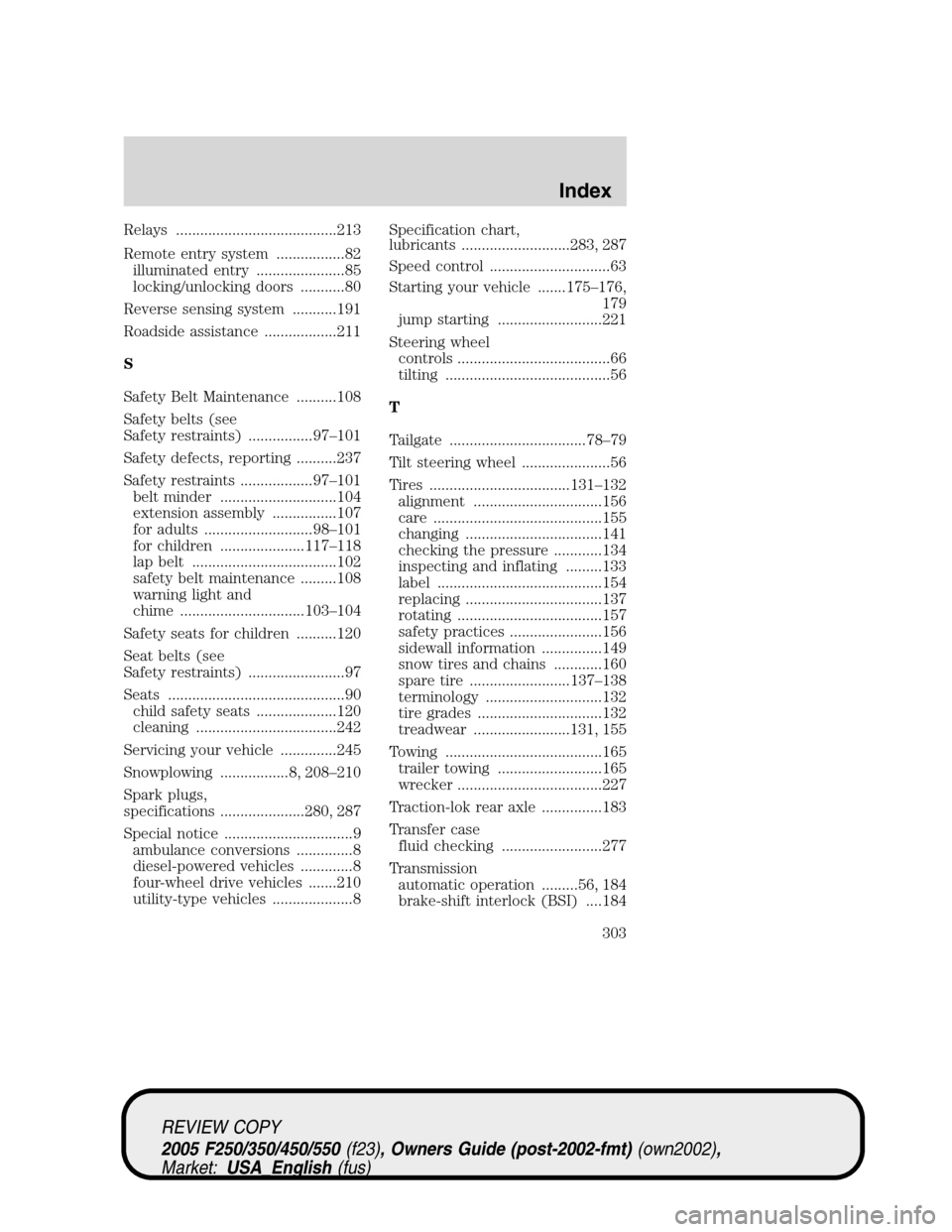Page 211 of 304

GETTING ROADSIDE ASSISTANCE
To fully assist you should you have a vehicle concern, Ford Motor
Company offers a complimentary roadside assistance program. This
program is separate from the New Vehicle Limited Warranty. The service
is available:
•24–hours, seven days a week
•for the New Vehicle Limited Warranty period of three years or
36,000 miles (60,000 km), whichever occurs first on Ford and Mercury
vehicles, and four years or 50,000 miles (80,000 km) on Lincoln
vehicles.
Roadside assistance will cover:
•a flat tire change with a good spare (except Ford GT which has a tire
inflation kit)
•battery jump start
•lock-out assistance (key replacement cost is the customer’s
responsibility)
•fuel delivery (2.0 gallons [7.5L], maximum two occurrences within 12
month period)
•towing of your disabled vehicle to the nearest Ford Motor Company
dealership, or your selling dealer if within 35 miles (56.3 km) of the
nearest Ford Motor Company dealership (one tow per disablement).
Even non-warranty related tows, like accidents, are covered (some
exclusions apply, such as impound towing or repossession).
Canadian customers refer to your Owner Information Guide for
information on:
•coverage period
•exact fuel amounts
•towing of your disabled vehicle
•emergency travel expense reimbursement
•travel planning benefits
USING ROADSIDE ASSISTANCE
Complete the roadside assistance identification card and place it in your
wallet for quick reference. In the United States, this card is found in the
Owner Guide portfolio in the glove compartment. In Canada, the card is
found in theOwner Information Guidein the glove compartment.
U.S. Ford or Mercury vehicle customers who require roadside assistance,
call 1–800–241–3673; Lincoln vehicle customers call 1–800–521–4140.
REVIEW COPY
2005 F250/350/450/550(f23), Owners Guide (post-2002-fmt)(own2002),
Market:USA_English(fus)
Roadside Emergencies
Roadside Emergencies
211
Page 268 of 304

Maintenance
•Keep tires properly inflated and use only recommended size.
•Operating a vehicle with the wheels out of alignment will reduce fuel
economy.
•Use recommended engine oil. Refer toLubricant specificationsin
this chapter.
•Perform all regularly scheduled maintenance items. Follow the
recommended maintenance schedule and owner maintenance checks
found in your vehicle scheduled maintenance guide.
Conditions
•Heavily loading a vehicle or towing a trailer may reduce fuel economy
at any speed.
•Carrying unnecessary weight may reduce fuel economy (approximately
1 mpg [0.4 km/L] is lost for every 400 lb [180 kg] of weight carried).
•Adding certain accessories to your vehicle (for example bug
deflectors, rollbars/light bars, running boards, ski/luggage racks) may
reduce fuel economy.
•Using fuel blended with alcohol may lower fuel economy.
•Fuel economy may decrease with lower temperatures during the first
8–10 miles (12–16 km) of driving.
•Driving on flat terrain offers improved fuel economy as compared to
driving on hilly terrain.
•Transmissions give their best fuel economy when operated in the top
cruise gear and with steady pressure on the gas pedal.
•Four-wheel-drive operation (if equipped) is less fuel efficient than
two-wheel-drive operation.
•Close windows for high speed driving.
EPA window sticker
Every new vehicle should have the EPA window sticker. Contact your
dealer if the window sticker is not supplied with your vehicle. The EPA
window sticker should be your guide for the fuel economy comparisons
with other vehicles.
It is important to note the box in the lower left corner of the window
sticker. These numbers represent the Range of MPG (L/100 km)
expected on the vehicle under optimum conditions. Your fuel economy
may vary depending upon the method of operation and conditions.
REVIEW COPY
2005 F250/350/450/550(f23), Owners Guide (post-2002-fmt)(own2002),
Market:USA_English(fus)
Maintenance and Specifications
268
Page 303 of 304

Relays ........................................213
Remote entry system .................82
illuminated entry ......................85
locking/unlocking doors ...........80
Reverse sensing system ...........191
Roadside assistance ..................211
S
Safety Belt Maintenance ..........108
Safety belts (see
Safety restraints) ................97–101
Safety defects, reporting ..........237
Safety restraints ..................97–101
belt minder .............................104
extension assembly ................107
for adults ...........................98–101
for children .....................117–118
lap belt ....................................102
safety belt maintenance .........108
warning light and
chime ...............................103–104
Safety seats for children ..........120
Seat belts (see
Safety restraints) ........................97
Seats ............................................90
child safety seats ....................120
cleaning ...................................242
Servicing your vehicle ..............245
Snowplowing .................8, 208–210
Spark plugs,
specifications .....................280, 287
Special notice ................................9
ambulance conversions ..............8
diesel-powered vehicles .............8
four-wheel drive vehicles .......210
utility-type vehicles ....................8Specification chart,
lubricants ...........................283, 287
Speed control ..............................63
Starting your vehicle .......175–176,
179
jump starting ..........................221
Steering wheel
controls ......................................66
tilting .........................................56
T
Tailgate ..................................78–79
Tilt steering wheel ......................56
Tires ...................................131–132
alignment ................................156
care ..........................................155
changing ..................................141
checking the pressure ............134
inspecting and inflating .........133
label .........................................154
replacing ..................................137
rotating ....................................157
safety practices .......................156
sidewall information ...............149
snow tires and chains ............160
spare tire .........................137–138
terminology .............................132
tire grades ...............................132
treadwear ........................131, 155
Towing .......................................165
trailer towing ..........................165
wrecker ....................................227
Traction-lok rear axle ...............183
Transfer case
fluid checking .........................277
Transmission
automatic operation .........56, 184
brake-shift interlock (BSI) ....184
REVIEW COPY
2005 F250/350/450/550(f23), Owners Guide (post-2002-fmt)(own2002),
Market:USA_English(fus)
Index
303